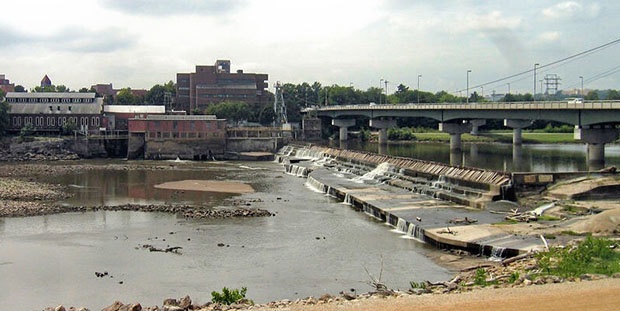Coupled Climate, Cultivation and Culture in the Great Plains: Understanding Water Supply and Water Quality in a Fragile Landscape
Investigators:
Richard Lehrter, M.S. Student
Professional Colleagues:
Dr. Melinda Daniels
Dr. Marcellus Caldas
Dr. J. Heier Stamm
Dr. Jason Bergtold
Dr. Aleksey Sheshukov
Dr. Matthew Sanderson
Dr. Dave Haukos
Project Supervisor:
Dr. Martha Mather
Cooperators:
Kansas State University,
Division of Biology
Funding:
National Science Foundation
Location: Smoky Hill River
Completion: December 2017
Status: Completed
Objectives:
Address how interacting dynamics between climate variation, human land and water use decisions, and aquatic ecosystem dynamics will affect fish biodiversity.
Progress and Results:
Overall
Models are needed that account explicitly for human-landscape interactions. In the four components of this proposal, an interdisciplinary team develops a coupled human-landscape model that incorporates atmospheric, terrestrial, aquatic, and social processes to predict the potential impact of climate variability, climate change, land use, and human activity on water resources. In this specific project, we evaluate the effects of the above on native Kansas fish biodiversity.
Throughout the U.S., freshwater ecosystems provide valuable societal goods and services that are being adversely affected by humans. Climate likely is exacerbating these adverse impacts. Great Plains rivers are model systems for coevolved animal community that inhabit naturally-connected dendritic ecosystems that are adversely affected by climate change and human land and water use.
Our collaborative research is unique in that it integrates multiple disciplines with the goal of understanding how water systems in the Great Plains (geomorphology, hydrology, ecology) are affected by human land and water use, as well as, how humans value the components of an aquatic ecosystem. All stakeholders (farmers, ranchers, urban residents, conservationists, anglers) will benefit from our interdisciplinary insights about how aquatic ecosystems are structured and function.
Aquatic biodiversity (e.g., fish biodiversity) has intrinsic ecological value. For example, communities with native biodiversity are often more resilient and better able to respond to disturbances. Biodiversity is also valued by a diverse human stakeholders including groups interested in conservation, recreation, and hunting-fishing. Thus, biodiversity is a natural link for coupling human and natural systems.
Fish comprise a large biomass in aquatic systems and have several attributes that make them an ideal focus for interdisciplinary research on natural and anthropogenic process drivers of biodiversity. First, fish distribution is strongly linked to geomorphology, hydrology, and land use. Second, fish represent an important component of ecological diversity. As such, they are a good taxa to examine how biodiversity is affected by human and climatic influences. Third, many human groups value fish. Thus, these charismatic megafauna, are an obvious link between natural and human systems.
This project's contribution to this collaboration will be to relate distribution of fish communities to environmental impacts. By coordinating fish biodiversity sampling in the Smoky Hill River with geomorphology, hydrology, and land use, our research team will better understand how humans impact aquatic systems. This information will be combined with human surveys of use and value to advance science and increase the efficiency of conservation efforts.
Graduate Research
Ricky Lehrter's MS thesis entitled "Links between anthropogenic disturbance and aquatic biodiversity in the Smoky Hill River, KS examines how anthropogenic effects of land and water use influence fish biodiversity in the Smoky Hill River, KS. The original overarching question for this project is: "What are the drivers of freshwater fish biodiversity that maintain resilience and sustain freshwater ecosystems in the face of human impacts and climate change?" The three approaches used to link fish biodiversity to environmental disturbance are to compare: (1) present and past samples at the same site (historical approach), (2) present more-impacted and present less-impacted sites within the Smoky Hill watershed (present time gradient approach), and (3) more impacted Smoky Hill watershed samples and a less-impacted Neosho watershed samples (across basin approach). Thus far (a) a literature review of drivers, fish biodiversity responses, and analysis methods is underway (b) fish guilds are being summarized for the Smoky Hill River. (c) We have also acquired all historical Kansas fish data to date (201 samples for the Smoky Hill watershed). Historical samples were split into time categories (pre-reservoir (1954), post-reservoir to 1969, 1970- 1989, 1990-1999, and 2000-2015. Repeated samples per time period have been identified: pre-reservoir (3), post-reservoir (16), 1970-1989 (22), 1990-1999 (59), and 2000-2015 (86). (d) During 30 fish sampling days within the summer of 2015, we collected fish at 53 Smoky Hill River sites that span a longitudinal gradient and include tributary-mainstem comparisons.
Products:
Publications:
Caldas, M.M, M. Sanderson, M. Mather, M. Daniels, J. Bergtold, J. Aistrup, J.H. Stamm, D. Haukos, K. Mankin, A. Sheshukov, and D. Carr-Lopez. 2015. Bringing culture into sustainability science research and policy. Proceedings National Academy of Sciences 112:8157-8159.
Professional Presentations:
Lehrter, R., and M.E. Mather. 2017. Geographic Region, Land use, Flow, and Discontinuities Influence Fish Biodiversity across Regions in a Great Plains Watershed. Kansas Natural Resources Conference, Wichita, KS. (Poster).
Lehrter, R. 2015. Fish Biodiversity as a Component of Ecosystem Function and Indicator of Environmental Degradation in a Great Plains River. Governor's Conference on the Future of Water in Kansas, Manhattan, KS. (Poster)